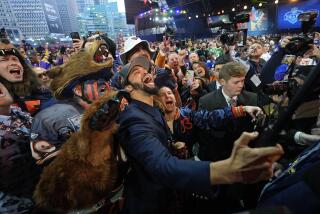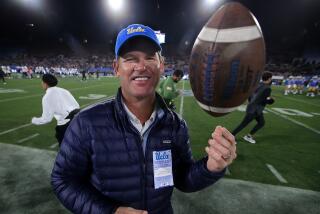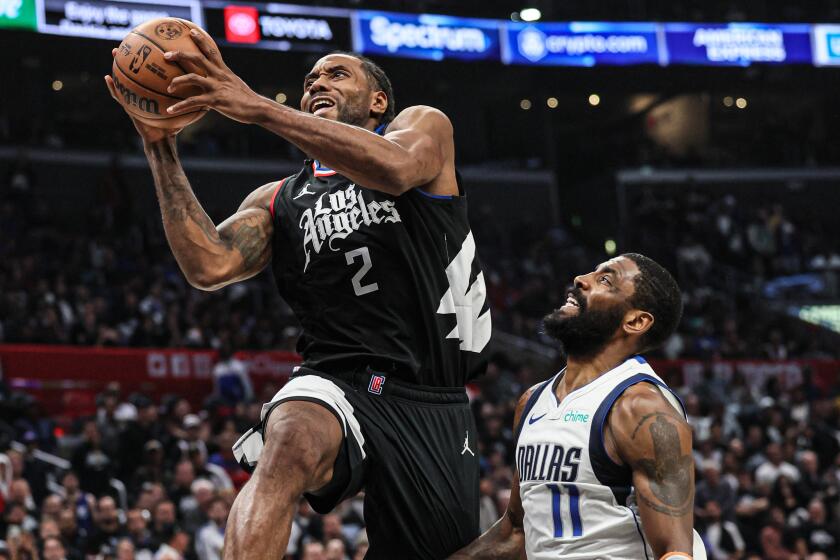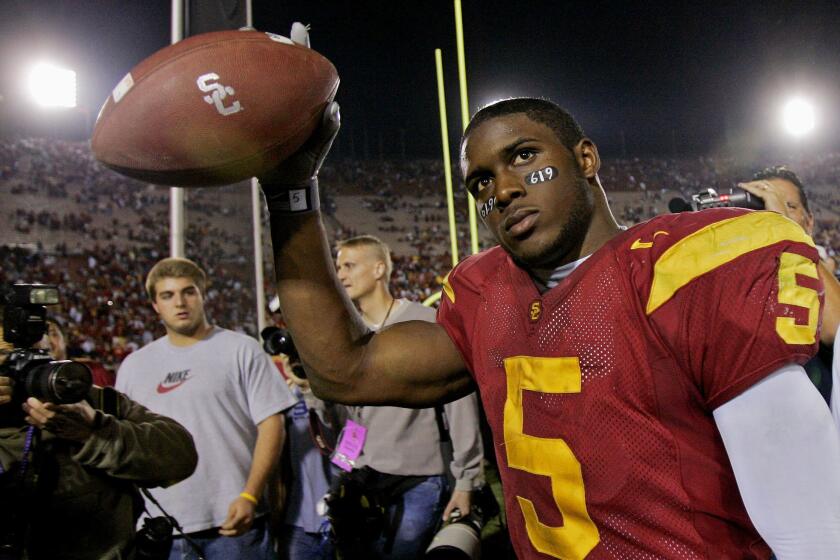Picking a quarterback No. 1 is risky
The Detroit Lions, who haven’t won a game since 2007, are thinking about using the No. 1 pick in next weekend’s NFL draft on Georgia quarterback Matthew Stafford.
If they do, the Lions are nuts.
It’s not a knock on Stafford, who one day might be a very good pro quarterback. It’s also not to suggest that USC’s Mark Sanchez should go to the Lions, even though he would happily buy a winter coat and hop the next plane to the Motor City.
The problem is Detroit has so many areas of need -- including a defense that has been ranked last for the past two seasons -- that putting the weight of expectation on the shoulders of a rookie quarterback could push his confidence through a wood chipper.
Use history as a guide. Look back a decade at the 1999 draft, when five quarterbacks were selected in the first 12 picks. Only two of those guys are still in the league: Philadelphia’s Donovan McNabb and Detroit’s Daunte Culpepper.
The other three are forgettable footnotes: Tim Couch, taken first by the expansion Cleveland Browns; Akili Smith, picked third by Cincinnati; and UCLA’s Cade McNown, chosen 12th by Chicago.
All three looked promising. All three fizzled with the teams that drafted them, then faded into obscurity with subsequent teams.
“My biggest fear for Matthew Stafford would be him having an opportunity to play this year,” said Smith, who now works with quarterbacks at Grossmont College in El Cajon, Calif. “If Daunte can just play well, let [Stafford] sit and learn the speed of the game, the system, I think he’ll be fine. But if he gets thrown in there, when fans start putting garbage bags on their heads, it’s going to be hell on him.”
Well, “biggest fear” might not be the right words. He isn’t sitting at home wringing his hands over the future of Stafford, who soon will be a millionaire at least 30 times over. But Smith knows all about those giant sandbags of expectation, and the incredible challenge of turning around a bad team.
“Every waking moment, you know you’ve got the organization on your shoulders, the whole city on your shoulders,” he said in a phone interview. “It’s too tough, too many negative vibes. The locker room becomes a very tough place, and when it’s like that, you’re just not going to have success.”
That’s not to say it can’t be done. The Atlanta Falcons went from 4-12 in 2007 to the playoffs last season, thanks in large part to rookie quarterback Matt Ryan, who threw for a touchdown on the first pass of his NFL career. But the Falcons also had the league’s second-ranked running game last season, the same type of support that helped Pittsburgh’s Ben Roethlisberger so much during his record-setting rookie season. (Roethlisberger also had the benefit of a great defense.)
Detroit, which was always playing catch-up, had the league’s 30th-ranked rushing game last season. That would be of little comfort to a rookie quarterback.
“The ideal model is to have a rookie quarterback sit for a year or two and learn under the tutelage of a savvy veteran,” said agent Leigh Steinberg, whose former clients include top picks Steve Bartkowski, Troy Aikman, Jeff George and Drew Bledsoe. He also had Smith and No. 2 pick Ryan Leaf, perhaps the NFL’s biggest bust.
That sit-a-season model is also unrealistic, considering the money invested in rookies and the pressure to get them on the field right away. Philadelphia’s Andy Reid showed incredible patience and restraint in keeping the rookie McNabb off the field as long as he did, and that didn’t even last a season.
The way Smith sees it, his entire career would have been different had he been given the opportunity to sit and learn. That conjecture is moot. In his four years with the Bengals, he was 3-14 as a starter.
Neither Couch nor McNown fared much better. All were colossal disappointments.
So what should the Lions do? Trading down for more picks would be helpful, though it’s unlikely they will get the type of value they want for that spot. They could also take one of the two top offensive tackles, Virginia’s Eugene Monroe or Baylor’s Jason Smith, and hope he plays the way Jake Long did in Miami or Joe Thomas did in Cleveland. Then, there’s taking Wake Forest linebacker Aaron Curry, who some analysts see as the safest pick in the draft.
In the end, though, the Lions probably will take Stafford.
And pray.
--
--
(BEGIN TEXT OF INFOBOX)
1999 NFL draft
Ten years ago, the NFL draft was said to be filled with overwhelming quarterback talent, and five were chosen in the first 12 picks. Only two, however, enjoyed success:
Tim Couch
Kentucky
1
Five seasons with Browns, 59 starts, 22 wins, 75.1 passer rating
Donovan McNabb
Syracuse
2
10 seasons with Eagles, five Pro Bowls, five NFC title games, one Super Bowl
Akili Smith
Oregon
3
Four seasons with Bengals, 17 starts, three wins, 52.8 passer rating
Daunte Culpepper
Central Florida
11
First seven seasons with Vikings, three Pro Bowls before serious knee injury
Cade McNown
UCLA
12
Two seasons with Bears, 12 starts, three wins, 67.6 passer rating
--
2009 NFL draft
This year’s draft has two exceptional quarterback prospects; after them, though, there are few notable players at that position:
1. MATTHEW STAFFORD, Georgia -- Height: 6-3, Weight: 228
* Stafford was a top-level recruit entering Georgia and now leaving will be a top-level NFL draftee. Huge arm. Where he’ll be taken: first pick.
2. MARK SANCHEZ, USC -- Height: 6-3, Weight: 225
* He reads defenses very well and follows his progressions well. Very good mobility. Where he’ll be taken: early as fourth, in top 10.
3. JOSH FREEMAN, Kansas State -- Height: 6-6, Weight: 250
* Freeman is probably the most physically imposing QB in the draft. Strong build and top-level arm. Where he’ll be taken: Mid-first round.
OTHER QBs
RHETT BOMAR, Sam Houston State, HT: 6-2, WT: 220
NATE DAVIS, Ball State, HT: 6-1, WT: 220
GRAHAM HARRELL, Texas Tech, HT: 6-3, WT: 205
PAT WHITE, West Virginia, HT: 6-1, WT: 192 (Will play WR in the NFL)
Sources: Los Angeles Times, nfl.com, profootballtalk.com, football-reference.com
Los Angeles Times
More to Read
Get our high school sports newsletter
Prep Rally is devoted to the SoCal high school sports experience, bringing you scores, stories and a behind-the-scenes look at what makes prep sports so popular.
You may occasionally receive promotional content from the Los Angeles Times.







